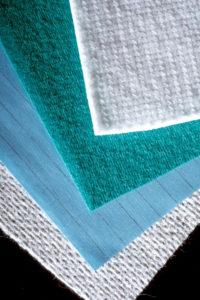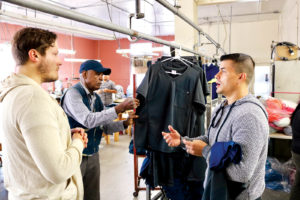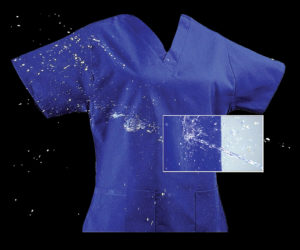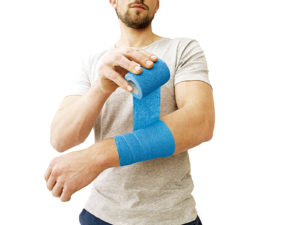
It’s probably safe to say that producing fabrics for the health care industry involves challenges unmatched by any other market.
To start with, protective properties obviously need to be a key component of all medical fabrics, given the presence of pathogens in health care settings. At any given time, one out of 25 hospital patients in the United States is affected by health care-associated infections (HAIs), according to a survey in the New England Journal of Medicine.
That’s one reason so many suppliers and manufacturers are seeking advancements in the kind of health care products (gowns, scrubs, sheets, caps) that are often referred to as durable nonwovens. Companies are looking for new and innovative ways to produce and market materials that keep both patients and health care workers safe in a difficult environment.
But protection is only one concern. The issue of sustainability is an increasingly important component, with manufacturers attempting to differentiate their products with antimicrobial treatments that retain their effectiveness through a greater number of washings. The chemical composition of the treatments is also under expanded scrutiny; manufacturers need to pay close attention to ensure that their own production processes prevent health issues and don’t cause them.
Also important are the look and feel of nonwoven durables; products that are scratchy or uncomfortable to wear won’t attract sustained interest no matter what protective advantages they may bring.
Finally, there’s the issue of cost. In a health care setting where frontline employees are often responsible for buying their own workwear, price is important.
Marketing challenges

It’s one thing to produce garments that protect wearers from pathogens. It’s quite another to get those garments into the hands of the people who need them most. A key issue facing companies producing durable nonwovens with special properties is that “active barrier apparel” with its potential benefits is a relatively new concept, according to Marc Lessem, chief marketing officer for Vestagen Protective Technologies Inc., based in Orlando, Fla.
Vestagen was founded in 2009 to develop and market high-performance textiles for health care and other applications. Its VESTEX® brand is engineered with liquid repellency, breathability and antimicrobial properties. It’s designed to be worn as comfortable, everyday general-purpose hospital attire while also minimizing the risks, to both health care workers and patients, associated with unanticipated fluid exposures. The first multi-hospital system adopted VESTEX in 2014. Other well-known hospital systems have signed on since then.
“Since we have only been commercially available a few years, we’re still working to build our brand,” Lessem says. “Part of the challenge is that there’s a general aversion to change. Change is risky. So, we mitigate that risk by providing decision-makers with scientific and staff preference data. That makes it easier for them to take the VESTEX leap.”
Highlighting published clinical data showing that VESTEX works in a hospital setting is key, Lessem says. Since many health care workers buy their own uniforms, the next challenge is getting hospital decision-makers to endorse or mandate an active barrier apparel policy. And then comes perhaps the toughest part for Vestagen—convincing employees to buy VESTEX over their traditional nonprotective uniforms.
“Chief nursing officers commonly want VESTEX because it’s been proven in a clinical setting to have an impact on certain tested bacteria, such as MRSA [Methicillin-resistant Staphylococcus aureus],” says Lessem. “But most hospitals don’t buy uniforms or mandate brand selection for their workers. Often, these employees buy their own uniforms and need only to follow color standards. Our challenge is to provide them with easy access to VESTEX when they are accustomed to purchasing their uniforms at an online or brick-and-mortar uniform store.”
Culture of safety
One successful adoption strategy is for hospitals to demonstrate their commitment to a culture of safety by purchasing the first sets of VESTEX uniforms for staff, Lessem says. “This builds high levels of employee engagement and generates VESTEX brand loyalty.”

Vestagen also works with its sales and marketing partner, Standard Textile Inc., to build customized webstores for employees to buy products directly. “Online works because between our field sales personnel and online tools, we deliver our message effectively,” Lessem says. “Like most products, VESTEX looks good on a clothes rack, but we’re not like most products. You’ve got to see our fluid repellence, hear about the antimicrobial properties and feel our comfort (the breathability and wicking features). This level of product detailing is not typical at most uniform outlets.”
In addition, according to Lessem, the profit margins required by retailers would make VESTEX more expensive than traditional uniforms. “We don’t want to be more expensive,” he says. “We want to be competitively priced with traditional non-protective garments, and we want to give customers a lot more for their money. Our customers should not have to choose between price and protection. They can have both.”
Focus on sustainability
PurThread Technologies Inc., founded in 2009 in Cary, N.C., manufactures antimicrobial fibers and yarns for the health care industry, as well as other markets. PurThread embeds silver salts into fibers at the molten stage of production. The process, the company says, “yields unsurpassed efficacy, durability and versatility to textile product designers and manufacturers.”
Sustainability has been an important consideration for PurThread since the company’s beginning, and as it becomes an increasingly important environmental issue, the company is positioned to differentiate itself by that distinction, according to Lisa Grimes, PurThread’s president and chief executive officer.
“Sustainability is important to us,” Grimes says. “We’ve done lots of studies to make sure they [silver salts] remain in the fabric—the research is there. We control the starting levels of silver salt we are using and have measured it through 100 industrial washings. Even after 100 washings, the overwhelming majority of silver is still there, and so is the efficacy. That’s very different than a lot of products that wash right out.”
The advantage of sustainability becomes an especially important point for PurThread when it’s compared to disposable products (which don’t need to be laundered), Grimes notes. “You do have some people who look at disposables and want to start comparing,” she says. “But when you weigh in the sustainability aspect, that’s something that doesn’t really favor disposables. Spending a little more money at the front end offers greater value in the long run.”
In addition, Grimes says, PurThread’s silver salts work well when combined with other additives that are needed in specific products for other purposes.
“Some functional products on the market have a hard time playing well with other products,” Grimes explains. “We’ve worked with clients to make sure we’re compatible with fire-retardant products. Privacy curtains, for example, must be flame-retardant. And by using silver salt, PurThread is not at all conductive. That’s very important in a hospital setting.”
Customer partnerships
Herculite® Inc., located in Emigsville, Pa., has been producing high-performance laminated and coated fabrics for more than 60 years, including the Sure-Chek® brand (originally Staph-Chek®), patented for use in protective coverings, and is a pioneer in the industry. Sure-Chek is used for products such as mattresses, bedding, privacy curtains and pillows.
One thing Herculite has learned over the years is that the innovation needed to succeed in the industry does not come from just inside the company, according to Leslie Haddad, Herculite’s health care fabrics business manager.
Sure-Chek was developed with the input of health care professionals whose opinions helped the company in the creation of its materials. Since then Herculite has formalized a process for customer interaction it calls the Discovery Methodology.
“We developed many of what are now considered standard features in health care fabrics,” says Haddad. “That was done with professionals in the industry years ago, and we have worked with them since then. That relationship is a focus. Our innovation often comes from working with our customers.”
With Discovery Methodology, Haddad says, “We invite our customers to collaborate with us on what exactly their needs and wants are, with the goal of finding ways to reduce cost, improve efficiencies and increase their sales. We work together as a team—their team and our team—to identify the areas and prioritize the ideas that would have the greatest impact. We work out a timeline, create a proposal and determine a way of validating how we reach our goals.”
“It sounds simple,” Haddad says, “but the key is the fact that it gives individual attention to the companies we work with. It’s been really effective for us.”
The process allows Herculite to stay up-to-date on what’s important to customers, Haddad says. “For example, right now we know customers are looking for improved comfort in products such as mattresses. There’s also more concern about hospitals being healthy environments, that materials and products being brought in don’t create additional health issues.”
Jeff Moravec is a freelance writer from Minneapolis, Minn.

Sustainability is a central focus for Covestro LLC, based in Pittsburgh, Pa., the North American affiliate to Covestro AG. The company produces coatings for medical textiles and materials for bandages, foams, adhesives, films and sealants in medical devices.
A problem in the industry has been the use of N,N-Dimethylformamide (DMF), which has long been a common solvent in the production of certain medical textiles. One issue with the use of this solvent is the amount of water needed to remove DMF before product packaging. There are also potential health and environmental hazards to consider during the manufacture and use of the products using DMF and other solvents.
The solution, according to Bentley Mah, senior technical sales specialist at Covestro, is to employ waterborne polyurethane dispersions (PUDs), coatings and adhesives that use water as the primary solvent.
It’s a much more sustainable way to produce coated textiles, Mah says.
“For our medical products, we’re really focused on waterborne PUDs. We have a set of PUDs that can be mixed and matched to obtain the requirements of physical properties for nonwoven textiles,” Mah says, “whether it’s water or chemical resistance, a certain touch or feel, flexibility or tensile strength.”
There are multiple advantages to PUDs, Mah says, among them a lower energy and water consumption in the coating process.
“We know that scrutiny in terms of sustainability and the use of solvents will only increase,” Mah says. Covestro has been investing heavily in developing waterborne PUDs in medical and industrial applications.
 TEXTILES.ORG
TEXTILES.ORG


